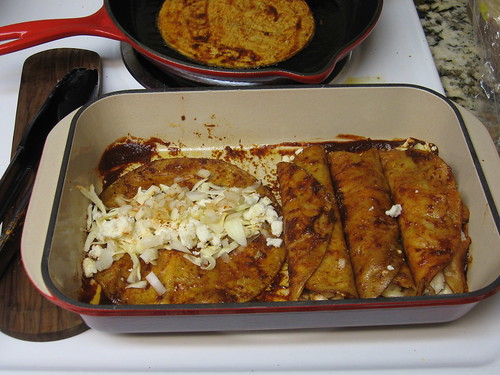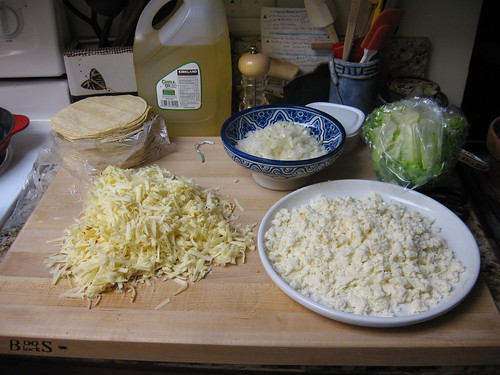I wish that I had taken notes, that it had been perfect and blog-worthy in that first moment, that I had taken a picture—but let it be known, Chicken-Chipotle tacos will be coming your way the next time I buy a chicken. In the meantime, let's talk enchiladas.

Living in Southern California, Mexican food is ubiquitous—the good and the bad, the traditional and the contemporary American style. For every delicious stand at the Grand Central Market, there is a restaurant serving stale food straight out of the microwave; for every traditional taquería, there is a fusion restaurant just down the street. Whether food is down-home traditional or more contemporary and upscale, I tend to like it, but my half-Mexican husband is a bit more picky.
When he was growing up, Mike's kitchen was the nexus of the family—every Saturday, his tías, cousins, and family friends would converge on their house. Carne asada, rice and beans, enchiladas, tamales, and more were served, and his mom was smart enough not to do the work on her own—at four o'clock in the morning Mike would be shaken awake, put to work chopping onions or shredding cheese. When visiting family in Mexico one summer, his grandmother woke his mother up, proudly displaying the healed blisters on his fingers that allowed him to flip tortillas over the open flame.
The family has diminished and scattered over the years, and it has taken half a decade for Mike & I to perfect some of our favorite family dishes. Salsa and guacamole were the first priorities, but they were followed closely by cheese and onion enchiladas.
There are a few keys to good and easy enchiladas. First, the sauce. It make take a bit longer than opening up a can, but once you've tried a homemade enchilada sauce, you'll never want anything else. It's little more than a very smooth salsa—chiles, garlic, and some tomato—but it has a rich, smoky, complex flavor. The sauce can be easily adapted, too: use vegetable or chicken stock instead of water for a richer flavor; add a roughly chopped chipotle for a more intense smoky flavor; add onions for a bit of texture and a more salsa-like taste.
The construction of the enchiladas is a bit messy, leading to an oil-splattered stove, but if you take a few minutes for mise en place, you will quickly fall into a rhythm. Here's my setup:
To the left I have my sauce on a plate, for dipping the tortillas, and some extra water for thinning the sauce if it gets too thick.

This is where I stand - I cook the tortillas on the back, then transfer them directly into the baking dish where I fill and wrap them.

To my right, I prepare all of my fillings and keep them close at hand; the tortillas and vegetable oil are also within easy reach.

The production of a large batch of food leads to a busy hum of work, a steady stream of things to do. It's one of my favorite times to be in the kitchen, preferably with a big mug of iced tea and a sunny window letting a cool breeze in. Once the enchiladas are in the oven (or freezer, as it may be), there's ample time to make some rice, set the table and sit down with a book for a few minutes before it's time to eat. And eating is the best part—it may have taken a while, but if I've learned anything from Mike, it's how to properly eat enchiladas.

See that big pile of vegetables on the plate? Mike grew up with enchiladas served with thick slices of iceberg lettuce, long wedges of cucumber, and cold, salted radishes. The cool crunch of the vegetables is the ideal foil for the creamy, spicy, and soft enchiladas. I've never heard of anyone else eating enchiladas like this, but I'll never go back.
Enchiladas come in many forms—nearly as many as there are families—but this recipe is basic: red mole for sauce, cheese and onions for filling. The assembly takes a bit of time, and for that reason I always make a fair batch—about two dozen. I recommend making it on a weekend; an ideal time to linger in the kitchen with family & friends, and perhaps a cold beer.
Cheese & Onion Enchiladas
I think the sauce is best if made the day before and refrigerated overnight; also, a tray of unbaked enchiladas will freeze quite well for at least a month; wrap tightly in plastic wrap, then aluminum foil. Remove the plastic wrap and replace the foil before baking (can be baked frozen).
Note: the leftover oil, laced with tortilla flavor and studded with little bits of browned mole, makes fantastic Mexican rice.
For the sauce:
4-6 cloves garlic
1 teaspoon dried oregano (or one sprig fresh, if available)
2 dried pasilla chiles (also called ancho)
7 dried guajillo chiles (also called California chiles)
3-4 dried chiles de arbol (optional)
2 tomatoes
salt to taste
(yields about 3 cups)
For the enchiladas:
2 dozen (six inch) corn tortillas
1 pound Monterey Jack, Pepper Jack, or other mild grating cheese
1 pound queso fresco (or an aged cheese like cotija)
1 large onion, finely chopped
oil, for frying the tortillas
To make the sauce: heat a heavy skillet (preferably cast iron) over medium heat. Add the dried chiles and the tomatoes and cook, turning regularly, until the tomatoes are beginning to blacken and the chiles are softened and fragrant but not burnt, 5-8 minutes.
Meanwhile, bring a couple cups of water to boil. When the chiles are done, add them to the pot, lower the heat to a simmer, and cover. The peppers will soften in 5-15 minutes.
Peel the garlic and toss it into a blender with the oregano. Discard the seeds and stems from the dried chiles, if you haven't already, and add the peppers to the blender. Peel and core the tomatoes and add them, as well. Add some of the chile water.
Blend the sauce thoroughly until it makes a sauce. Add more water as needed to achieve a thickness like applesauce, and add salt to taste. You should have about three cups of sauce. If you're making the sauce ahead of time, let cool, then cover and refrigerate overnight or up to a week.
To assemble the enchiladas, prepare all the fillings: grate the Jack cheese, crumble the queso fresco, and chop the onions; keep all of them close at hand. Also keep two baking dishes handy—for a thin layer of enchiladas, use two 9 by 13 pans, for a thicker layer (you will push the enchiladas together; this is how I prefer them), use one 8 inch square pan and one 9 by 13 or 8 by 12 pan. You will also need the cooking oil, the enchilada sauce, and some water for thinning the sauce as needed.
Preheat the oven to 350ºF. Heat a generous layer of oil at medium-high heat in a 12 inch cast iron skillet. Spread some of the sauce into the baking dish and pour some onto a plate, thinning it with a bit of water if needed. Coat a tortilla on both sides with a layer of sauce (it does not need to soak) for long. With tongs, carefully place the tortilla in the oil—it will pop and sputter. Cook 15-30 seconds on each side, until the tortilla is pliable but not falling apart. Transfer to your baking dish and let cool for a few seconds, then add some of each cheese and a few onions, then fold and move to the side of the dish. Repeat, adding more oil to the pan as needed—after a few you should get into a rhythm, filling one cooled tortilla while another one is cooking and a third is sitting in the sauce.
Once all the tortillas are filled, thin the remaining sauce with about a quarter cup of water and distribute it over both of the baking dishes, getting sauce around all the edges and between enchiladas, if possible. Sprinkle the tops with the remaining cheese and cover with foil. Bake for 30 minutes, until the cheese is bubbling. Uncover and cook 10-15 minutes more.
Remove from the oven and let sit 5-10 minutes before serving—serve with an assortment of cold, crunchy vegetables, and rice and beans if desired.
Makes about 24 enchiladas

Yes. Just: yes.
ReplyDeleteWow, tasty. Does Mike (or do you?) know how to make homemade tortillas? I've always been tempted to try....
ReplyDeleteOh, the image of a little boy being shaken awake. So cruel, but I hope they are nice memories for him anyway.
Liana - I know, right? :)
ReplyDeleteNicole - We regularly (but not always) make our own flour tortillas. I used to make my corn tortillas, whether by mixing the masa myself or buying pre-mixed masa dough and just shaping them. However, there's a tortilla factory on my way home from work where I can buy three dozen corn tortillas, made freshly that day, for about $2.50. I've gotten spoiled by some aspects of living in L.A.!